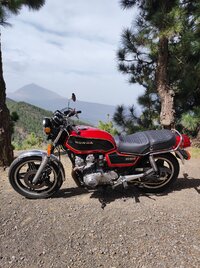Good afternoon everyone. They would help me a lot if you try to help me with my problem. I have a 1982 CB750 KZ, RC01.
The motorcycle was stopped for 25 years when I bought it. I restored everything I could myself, but I did not open the engine.
I cleaned the carburetion myself, but the bike has the problem that it starts well, but once it warms up the idle speed changes and goes up little by little, that is, as it warms up I have to adjust the idle speed.
The bike has been in 2 different workshops. The first carburation was cleaned, adjusted with a vacuum gauge and the problem persists.
The second workshop in which he has been has gone further and in addition to cleaning the entire system again, they have adjusted the valves and have mistakenly changed the lowjet but the motorcycle continues to have the same problem, and now it fails at low revs .
I have measured the compression and it is not very good. When cold they give approximately 116 psi each cylinder and when hot 130 psi.
It does not seem to have vacuum leaks, which also, if it were so, would always give the same failure both when hot and cold.
Does anyone know what I'm missing?
The motorcycle was stopped for 25 years when I bought it. I restored everything I could myself, but I did not open the engine.
I cleaned the carburetion myself, but the bike has the problem that it starts well, but once it warms up the idle speed changes and goes up little by little, that is, as it warms up I have to adjust the idle speed.
The bike has been in 2 different workshops. The first carburation was cleaned, adjusted with a vacuum gauge and the problem persists.
The second workshop in which he has been has gone further and in addition to cleaning the entire system again, they have adjusted the valves and have mistakenly changed the lowjet but the motorcycle continues to have the same problem, and now it fails at low revs .
I have measured the compression and it is not very good. When cold they give approximately 116 psi each cylinder and when hot 130 psi.
It does not seem to have vacuum leaks, which also, if it were so, would always give the same failure both when hot and cold.
Does anyone know what I'm missing?

